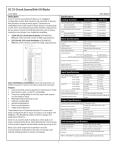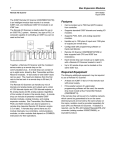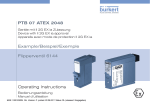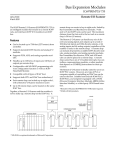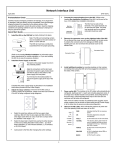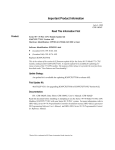Download to IC660BPM100 PDF for more information.
Transcript
This Datasheet for the IC660BPM100 Block Power TRAC 115Vac/125Vdc Power Monitor http://www.qualitrol.com/shop/p-14447-ic660bpm100.aspx Provides the wiring diagrams and installation guidelines for this GE Series 90-30 module. For further information, please contact Qualitrol Technical Support at 1-800-784-9385 [email protected] Power Monitoring Block IC66*BPM100 August 1995 H H H H H H H H H H H H H H Accurately measures the RMS values of voltage, current, power, VARs, power factor, and watthours, even with distorted waveforms. Measures line frequency. Detects and captures overcurrent waveforms above a configurable current level. Indicates magnitude of system harmonic content. For both wye (4-wire) and delta (3-wire) systems. Simple user connections. Direct connection for up to three potential transformers and three line current transformers plus one neutral current transformer. Low current transformer burden (less than 0.1VA). Software configurable, including scaling. Small size and rugged design for mounting in electrical distribution and process equipment. Integral power supply accepts either 115/230 VAC or 125 VDC inputs. Can be installed on bus up to 7500 feet from host. Compatible with CPU redundancy configurations. Can be used for stand-alone monitoring without a host. The Power Monitoring Block (IC66*BPM100) monitors current and voltage inputs and stores digitized waveform values for each input. From these values, the block calculates RMS values of voltage, current, active power, reactive power, KWH, and power factor. Frequency is also measured. The block automatically sends this calculated data to a programmable controller or host computer approximately twice per second. The same data can be displayed on a Hand-held Monitor from any location on the bus. If an overcurrent transient exceeds a configurable level, the block captures the resulting waveform. A simple measure of system harmonic content indicates the extent to which this problem exists. The block will supply waveform data to the PLC or computer, for harmonic or transient analysis, upon request. The block can be used with a wye or delta configured three-phase power system or with a single-phase GFK-0366E power system. It accepts voltage inputs from as many as three potential transformers, and current inputs from one to three line current transformers, plus a neutral current transformer. The turns ratios of both current transformers and potential transformers are software-configurable. Current transformers with a secondary rating of up to 5 amps and primary ratings up to 3275 amps for line connections or 325 amps for auxiliary (neutral) connections may be used. Potential transformers with a secondary rating up to 120VAC (47–63 Hz) and primary ratings up to 327KV may be used, with line-to-line or line-to neutral connections. ÎÎ Î ÎÎÎ Î ÎÎÎÎÎÎ Î Î ÎÎ ÎÎ ÎÎ ÎÎ ÎÎ ÎÎ ÎÎ ÎÎ ÎÎ ÎÎ ÎÎ Î ÎÎÎ a43592 The Power Monitoring Block can be powered from either 115/230 VAC (90–265 VAC) 47–63 Hz, or 125 VDC (100–150 VDC) at 1 amp, maximum. It can be installed on electrical distribution or process equipment, in a junction box, or rack or panel-mounted up to 7500 feet from the host. Use of a Hand-held Monitor also allows stand-alone operation. The block’s Electronics Assembly may be inserted or removed without disturbing block configuration or field wiring (no CT shorting clips are required). 2 Power Monitoring Block GFK-0366E Content of this Datasheet Calculated Data This datasheet describes the features and installation Approximately twice a second, the Power Monitoring Block calculates the following RMS values, based upon the current content of the Working Data Table. Operation Installation Configuration Specifications page 2 4 8 10 For additional information, see the Power Monitoring Block User’s Manual. Operation The Power Monitoring Block uses both analog and digital techniques to provide accurate and stable RMS measurements, even in the presence of higher-order harmonics. These measurements are fully updated about twice a second. To accomplish this, the block samples all current and voltage inputs at an equivalent rate of 128 samples per cycle. Samples are taken at the rate of 16 samples per cycle for 8 consecutive cycles. These composite waveforms are stored in a Working Data Table for computation of the new measurements. The stored waveforms may also be used for harmonic analysis; they can be read by the PLC or remote computer using Read Device datagrams. This is described in the Power Monitoring Block User’s Manual. CURRENT AND VOLTAGE INPUTS Ia Ib a43593 STATUS DATA SIGNAL CONDITIONING Ic Ix Va Vb Vc MULTIPLEXER B ANALOG TO DIGITAL CONVERTER WORKING DATA CALCULA TED DATA U S OVERCURRENT DATA XMIT DATA BUFFER Both voltage and current inputs are processed to maximize accuracy over the specified measurement range, while still providing the ability to track overload conditions at a reduced accuracy. Sampling is referenced to line frequency using phase-lock loop circuitry. All inputs are sampled simultaneously to maintain phase correlation. The digitized inputs are also stored in another internal table called the Overcurrent Data Table in order to support overcurrent transient capture. This feature is described on the next page. voltage, phase A to B voltage, phase B to C voltage, phase C to A voltage, phase A to N* voltage, phase B to N* voltage, phase C to N* current: phase A, B, and C current, auxiliary CT active power: phase A, B, and C reactive power: phase A, B, and C total power factor totalWH/KWH/MWH * for line-to-neutral PTs only Each bus scan, the block sends these 36 bytes of calculated data to the PLC or host computer. This data can also be displayed on a Hand-held Monitor in either a system or stand-alone configuration. In addition to the above data, the Power Monitoring Block calculates the following values: fundamental VARs: phase A, B, C fundamental Power Factor harmonic VARs as % of V-A: phase A, B, C harmonic VARs as % of total system V-A line Frequency temperature alarm status extended watt-hours All values are reported as 16-bit two’s complement numbers. Active Power, Reactive Power, and Power Factor are signed values. Calculated data has the following valid ranges: voltage: line current: aux. current: power: power factor: VARs: fund PF: har. VARs line freq.: temp. alarm: extended watt-hours (high): extended watt-hours (low): 0 to 327 KVolts 0 to 3276.7 Amps 0 to 327.67 Amps –32768 to +32767 –1.000 to +1.000 –32768 to +32767 –1.000 to +1.000 0 to 100 47.0 to 63.0 –1, 0, +1 0 to 32767 0 to 999 Power Monitoring Block 3 GFK-0366E Extended Data Enabled Status and Control Data The block also sends 16 bits of status data along with the 36 bytes of calculated data. In return, the PLC or computer sends 16 output control bits to the block each bus scan. This transfer of status and control bits establishes a “handshaking” protocol. Baud Rate 153.6 Kb. st 153.6 Kb. ext 76.8 Kb 38.4 Kb. A 5.02 5.10 10.18 20.384 B 5.38 5.46 10.90 21.814 CPU Memory Required The PLC or computer must reserve memory space for the automatic transfer of 36 bytes of calculated data, 16 bits of status data, and 16 bits of command data with the Power Monitoring Block. An IC600- series PLC must reserve 24 inputs and 16 outputs or 20 registers. Inputs are multiplexed, with the channel number in the MSB. An IC655- series PLC must reserve 304 inputs and 16 outputs or 20 registers. An IC697- series PLC must reserve 16 input bits for the block’s status data, 16 output bits for command data. If the block is configured NOT to send the extra data described previously, it requires 18 analog inputs for calculated data. If it is configured to send the extra data, it requires 30 analog inputs for calculated data. If the PLC or computer will read table data for transient or harmonic analysis, additional memory will be required. Overcurrent Transient Detection The block also stores the 128 sampled values for each input in the Overcurrent Data Table. There, they are arranged as 8 consecutive cycles of 16 points each. Data in the Overcurrent Data Table is updated continuously until an overcurrent transient is detected. If the current on any of the four current inputs exceeds a configured transient level for two successive samples, the block captures and stores three cycles up to and including the event, plus the five succeeding cycles of data. It then freezes the contents of the Overcurrent Data Table. This traps the digitized overcurrent waveform along with the three cycles before and the five cycles after it. a43594 I (A) 35 Bus Scan Contribution CURRENT TRANSIENT ABOVE CONFIGURED LEVEL FOR TWO SUCCESSIVE SAMPLES. NEXT 5 CYCLES WILL BE SAMPLED. 30 The scan time contribution for the block depends on the baud rate, the number of controllers on the bus and whether or not Extended Data reporting is enabled. The following tables show the scan time contribution at each baud rate, without Extended Data enabled or with Extended Data enabled. At the baud rate selected, use the time in column A if there is just one bus interface block on the bus capable of sending outputs to the block. If a second bus interface block on the bus is also capable of sending outputs to the block, use the time in column B instead. 25 20 CONFIGURED OVERCURRENT TRANSIENT LEVEL THESE TWO CYCLES OCCURRED BEFORE THE OVERCURRENT TRANSIENT CYCLE 2 CYCLE 3 CYCLE 4 15 10 5 Extended Data Not Enabled Baud Rate 153.6 Kb. st 153.6 Kb. ext 76.8 Kb 38.4 Kb. A B 3.30 3.38 6.76 13.52 3.66 3.74 7.48 14.95 When a current transient occurs, the block sets a bit in the status data it sends to the PLC or computer. Transient data can be read by the PLC or computer Read Device datagrams. This is described in the Power Monitoring Block User’s Manual 4 Power Monitoring Block GFK-0366E Installation Dimensions of the block are shown below. When planning the block’s location, be sure to allow adequate clearance for routing wiring and for airflow around the block. Also be sure to leave room at the front of the block for attaching a Hand-held Monitor. Î ÎÎ ÎÎÎÎ ÎÎÎÎ a43595 8.06 (20.47) .18 (.46) 5.21 (13.23) 2. Separate the block’s Electronics Assembly from the Terminal Assembly. Grasp the block firmly, and pull the Electronics Assembly out straight, away from the Terminal Assembly. ÎÎ ÎÎ TERMINAL ASSEMBLY a43597 11.00 (27.94) ÎÎÎÎ ÎÎ CONNECTORS DIMENSIONS IN INCHES, CENTIMETERS IN PARENTHESIS The Power Monitoring Block is most easily installed with the Electronics Assembly removed Installing the Terminal Assembly 1. Drill four mounting holes as indicated below at the intended location. .22 (.56) a43596 5.21 (13.23) 3.25 (8.26) .43 (1.09) ÎÎ Î ÎÎÎÎÎ Î RETAINING SCREWS (QTY 2) ELECTRONICS ASSEMBLY ÎÎÎÎÎ ÎÎ Î 3. Line up the notches in the top and bottom of the Terminal Assembly with the drilled holes. Fasten it securely in place using up to #12 screws with star washers. After installing the Terminal Assembly, complete the block wiring as described on the following pages. Wiring Information Each terminal can accept solid or stranded wires; the wires into any given terminal should be the same type and size. The terminals will accept bare wires, or spade or ring lugs. 10.56 (26.82) 11.00 (27.94) Bus Connections The bus connection terminals can accept two copper wires up to size AWG #14 (2.1mm2 cross section). The suggested torque is 9 in–lbs. Power and Field Wiring Connections DIMENSIONS IN INCHES, CENTIMETERS IN PARENTHESIS Connections to the remaining terminals can be made with copped conductors, wire sizes up AWG #10 (5.02mm2 cross section). The suggested torque is 12 in–lbs. Power Monitoring Block 5 GFK-0366E Bus Installation Wiring for Field Devices To install the block on a communications bus, connect its Serial 1 and Serial 2 terminals to those of adjacent devices. Connect Shield In to the Shield Out terminal of the previous device. Connect Shield Out to the Shield In terminal of the next device. The unshielded ends of the wires should not be longer than 2 inches. SERIAL 1 SERIAL 2 SHIELD IN SHIELD OUT Î Î Î Î Power must be NOT be applied to the Power Monitoring Block or input terminals when completing the field wiring. If conduit will be used to bring wires or cables for field inputs to the block, its size and installation should be in accordance with local electrical code. Power and Ground Wiring a43598 Block power may be from a 115/230 VAC or 125 VDC power source. For a 115 VAC power supply, connect the hot (black) wire to the H terminal. Connect the neutral (white) wire to the N terminal. For 230 VAC, connect the incoming line to the H and N terminals. For a DC power supply, connect the DC+ wire to the H terminal. Connect the DC- wire to the N terminal. Complete the power wiring by attaching the ground wire to one of the ground screws on the block. Ground the block by wiring one of its ground screws to the equipment chassis. If the block is the last device (electrically) on the bus, connect a terminating resistor of the appropriate impedance across the Serial 1 and Serial 2 terminals. GROUNDING SCREW If the block is being used by itself, and not connected to a bus, install a 75-ohm terminating resistor across the Serial 1 and Serial 2 terminals. ÎÎÎÎÎ Î ÎÎÎÎÎÎ a43599 Wiring for Bus Continuity Bus connections are normally considered permanent. They should never be removed while the completed system is in operation; the resulting unreliable data on the bus could cause hazardous control conditions. If the bus will control processes that cannot be shut down in the event it is necessary to remove or replace a block’s Terminal Assembly, bus connections can be made using intermediate connectors, or wire ends can be soldered together before inserting them into the terminals. For more information, see the I/O System User’s Manual. ALTERNATE GROUND CONNECTION POINT ÎÎÎÎÎ ÎÎÎÎÎ For correct calculation of power values, PTs and CTs must be connected to the power phases and to the block as shown in the following diagrams. If the PTs or CTs cannot be connected to the power phases as shown, refer to the Power Monitoring Block User’s Manual for instructions. 6 Power Monitoring Block GFK-0366E Number of PTs (L–N) Number of PTs (L –L) three Current/Voltage Input Terminals A/R B/S C/T A–N B–A C–N two A–N C–N B–N one three B–C two B–C C–A If there are just two line-to-neutral PTs, one must be connected from phase A to neutral and to the block’s R terminals. The other must be connected from phase C to neutral, and to the block’s T terminals. If there is just one line-to-neutral PT, it must be connected from phase B to neutral and to the block’s S terminals. Short unused inputs. A–B 3 Line-to-Neutral Potential Transformers A–B a43600 (LINE SIDE) C–A one N A B C R+ Number of CTs three phase A two phase A phase B phase C phase C R POWER S+ phase B one VOLTAGE S T+ Warning T (LOAD SIDE) For personal safety, PT AND CT SECONDARIES MUST BE GROUNDED. Recommended grounding is shown in the diagrams that follow. Power Flow Transformers should be connected to the block with the dots as shown in the wiring diagrams. If this is done, power flow in the direction indicated by the arrow in each illustration will provide a + reading for that input. 3 Line-to-Line Potential Transformers For proper calculation of power values, the block’s R, S, and T terminals must be connected to these line-to-neutral PTs: R terminals: S terminals: T terminals: Phase B to phase C PT Phase C to phase A PT Phase A to phase B PT B C Wiring from Potential Transformers R+ Refer to the examples below to connect potential transformers to the Power Monitoring Block. R POWER S+ For proper calculation of power values, the block’s R, S, and T terminals must be connected to these line-to-neutral PTs: R terminals: S terminals: T terminals: Phase A to neutral PT Phase B to neutral PT Phase C to neutral PT a43601 (LINE SIDE) A VOLTAGE S T+ T (LOAD SIDE) Power Monitoring Block 7 GFK-0366E 2 Line-to-Line Potential Transformers If there are just two line-to-line PTs, one must be connected from phase B to phase C and to the block’s R terminals. The other must be connected from phase A to phase B, and to the block’s T terminals. Connect the S terminals as shown. B 3 Line Current Transformers 1 Neutral Current Transformer a43602 (LINE SIDE) A current transformer input terminals. No spring-type contacts are used. Burden is maintained with the electronics block removed. POWER a43604 (LINE SIDE) C N A B C R+ A+ R A S+ POWER B+ VOLTAGE S B T+ C+ T C CURRENT (LOAD SIDE) X+ 1 Line-to-Line Potential Transformer X If there is just one line-to-line PT, it must be connected from phase C to phase A and to the block’s S terminals. Short the unused inputs. a43603 (LINE SIDE) A B C 2 Line Current Transformers 1 Neutral Current Transformer If there are just two line CTs, one must be connected from phase A to the block’s A terminals. The other must be connected from phase C to the block’s C terminals. R+ R POWER (LOAD SIDE) S+ VOLTAGE N A B C A+ T+ A T (LOAD SIDE) a43605 (LINE SIDE) S POWER B+ Wiring from Current Transformers B Refer to the examples below to connect current transformers to the Power Monitoring Block. For proper calculation of power values, the block’s A, B, and C terminals must be connected to phase A, B, and C respectively. C+ For safety, current transformer burdens are permanently and directly connected across the block’s CURRENT C X+ X (LOAD SIDE) 8 Power Monitoring Block GFK-0366E 1 Line Current Transformer 1 Neutral Current Transformer Caution If there is just one line CT, it must be connected from phase B to the block’s B terminals. a43606 (LINE SIDE) N A B C A+ A POWER B+ B CURRENT C+ Do not exert excessive force. Damage to the equipment can result. If unusual resistance is met, remove the Electronics Assembly. Check the keying and inspect the Terminal Assembly, connector receptacle, and connector edge board on the Electronics Assembly. If necessary, remove any obstacles and reinsert the Electronics Assembly. Pay close attention to the alignment of the guide pins. 3. Secure the Electronics Assembly with the screws on the top and bottom. 4. Apply power to the block. C X+ Compatibility X The Power Monitoring Block is compatible with: (LOAD SIDE) Warning NEVER disconnect any current transformer wiring from the Power Monitoring Block when current is flowing in the primary circuit. The resulting hazardous voltages MAY CAUSE INJURY OR DEATH. Install the Electronics Assembly The Electronics Assembly and Terminal Assembly are keyed to assure a correct installation. 1. Align the Electronics Assembly Use the shoulder screws on the side of the Terminal Assembly as a guide. 2. Push the Electronics Assembly down quickly. Hand-held Monitor: version 3.5 or later provides basic compatibility with a Power Monitoring Block. If the block is assigned to register references, HHM version 3.8 is required to display the additional calculated data listed on page 2. PLC CPUs: IC697CPU731G or later IC697CPU771E or later IC697CPUxxx: all versions IC600 series PLC CPU: rev. 105 or later IC600 PLUS series PLC CPU: rev. 110 or later IC655 series PLC CPU rev. 4.0 or later Programming Software (IC641SWP701/702) rel. 2.02 or later IC641PBE series software, release 4.02 or later IC641PFE500 or PTE series software, release 2.01 or later Bus Controllers: IC697BEM731C or later IC66*CBB902 or 903, version 1.7 or later. IC655BEM500, any version PCIM or QBIM: any version Power Monitoring Block 9 GFK-0366E The Power Monitoring Block must be configured with a Hand-held Monitor to: Power Display Units: Selects whether power measurements will be reported to the CPU as Watts, Megawatts, or Kilowatts. This entry is also used to scale VARs, power, and energy. H H PT Turns Ratio: Specifies the turns ratio of the PT(s). Range is up to 327600.0:120 (2730.0:1) maximum. Power Monitoring Block Configuration Enter its Block Number (serial bus device number). Enter its Reference Number (not required for PCIM or QBIM). The Power Monitoring Block requires 304 I/O references. Additional features of the block, described below, can be changed by configuration from the Hand-held Monitor or the application program. Selections and the default configuration of each feature are shown in the table at the bottom of the page. Baud Rate: May be 153.6 Kbaud standard, 153.6 Kbaud extended, 76.8 Kbaud, or 38.4 Kbaud. All devices on the bus must use the same baud rate. CPU Redundancy: Selects no redundancy or “Hot Standby” mode. Configuration Protection: Prevents accidental or unauthorized changes to the block’s configuration. PT Connection: Specifies whether the potential transformer connections are line-to-neutral or line-to-line. CT Turns Ratio: Specifies the turns ratio of the CT(s). Range is up to 3275:5 (6550:1) maximum. NCT Turns Ratio: Specifies the turns ratio of an NCT. Range is up to 325:5 (655:1) maximum. Overcurrent Transient: A value in peak Amps which represents the maximum allowable current on the current transformers. If a current transient above this level occurs, the block will continue to store the waveform for the next five cycles, and inform the CPU that a transient has occurred. The CPU can then request the transient data from the block. Auxiliary Overcurrent Transient: A value in peak Amps which represents the maximum allowable current on a neutral current transformer. This is handled as described above. Number of PTs: Specifies the number of potential transformers connected to the block (1 to 3). Sign Convention for VARs and Power Factor: Selects the sign convention used by the block. Number of CTs: Specifies the number of line current transformers connected to the block (1 to 3). Does not include the neutral current transformer. Send Extra Calculated Data: Can be used to enable automatic sending of the block’s additional calculated data (see page 2). Default Configuration Feature PT Connection Number of PTs Number of CTs Power Display Units PT Turns Ratio CT Turns Ratio NCT Turns Ratio Current Line Transient Auxiliary Current Transient Sign for VARs and Power Factor Send Extended Calculated Data Baud Rate BSM Present CPU Redundancy Config. Protect Selections line to line, line to neutral 1–3 1–3 Watts, MegaWatts, KiloWatts 1.0 to 2730.0 1 to 6550 1 to 655 up to 4500A up to 450A Mode A or Mode B no, yes 153.6 st, 153.6 ex, 76.8, 38.4 Kbaud yes/no none, hot standby enabled/disabled Default L–N 3 2 KWatts 60.0 200 5 3276 327 Mode A no 153.6 st no none disabled 10 Power Monitoring Block GFK-0366E Power Monitoring Block: Specifications Voltage Inputs: Maximum NominalRange Overvoltagerange Transientrange Burden per input Accuracy of measured voltages Configurable PT turns ratios Current Inputs: Nominalrange Transientrange Overcurrentwithstand Burden per input Accuracy of measured current Configurable CT turn ratios Frequency Accuracy: PowerMeasurement Accuracy: Power Supply Requirements: Terminal Wiring: LEDs: Functionality: Voltage Current Active Power Reactive Power Power Factor KWH UpdateRate Frequency Block Ambient Temp. Status Harmonics Environmental: OperatingTemperature Storage Temperature Humidity Vibration Dimensions H H one to three phases (delta or wye) 60 to 120 VAC RMS at 47 to 63 Hz up to 300V peak up to 300V peak less than 0.1 VA $ 0.25% reading + 0.25% full scale for nominal range 1.0:1 to 2730:1, up to 327KV one to three phases 0 to 5 Amps RMS at 47 to 63 Hz 5 to 50 Amps RMS at 47 to 63 Hz 50 amps for 5 seconds, at 10–minute intervals less than 0.1 VA $ 0.50% reading + 0.50% full scale 655 : 1 (up to 3200 amps) $ 0.1Hz $ 0.75% reading + 0.75% full scale (PF 0.8 or greater) 115 VAC/230V AC (90–265VAC), 47–63 Hz or 125 VDC (100–150VDC) at 35VA max. for I/O bus: one AWG #12 or two AWG #14) for power, CTs, and PTs: up to AWG #10 Unit OK, Communications OK Per phase Per phase and neutral Per phase Reactive Power Effective system PF Total system 2/second system low, normal, high total harmonicpowercontent/phase 0°C to +60°C (+32°F to +140°F) –40 °C to +100°C (–40°F to +212°F) 5% to 95% non-condensing 1.0 G 10–200Hz 5.21” w. X 11.00” h. X 8.06” d. 13.23cm w. X 27.94cm h. X 20.47cm d. Electronics removable from terminal strip while maintaining electrical continuity on CT secondaries. Designed in accordance with UL and CSA, ANSI C37.90, NEMA 2-230, IEEE 587











